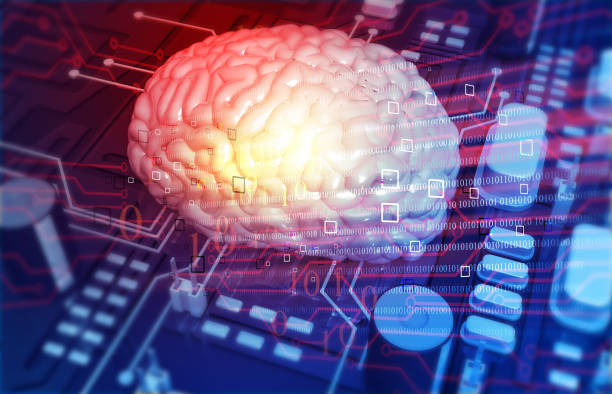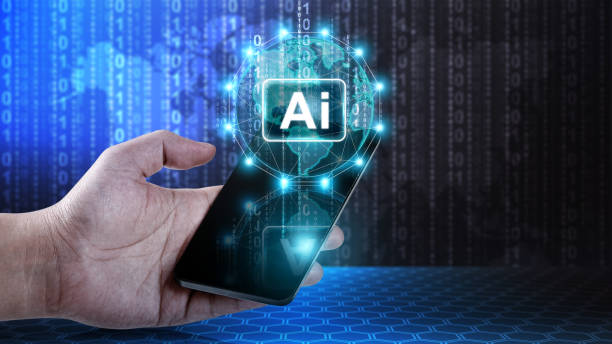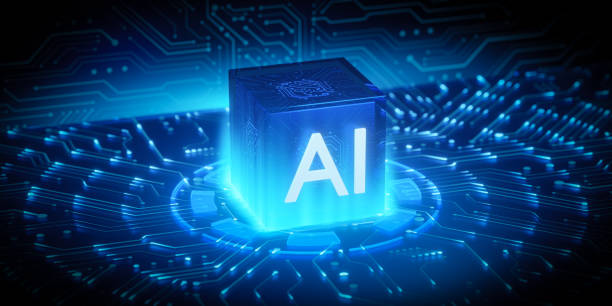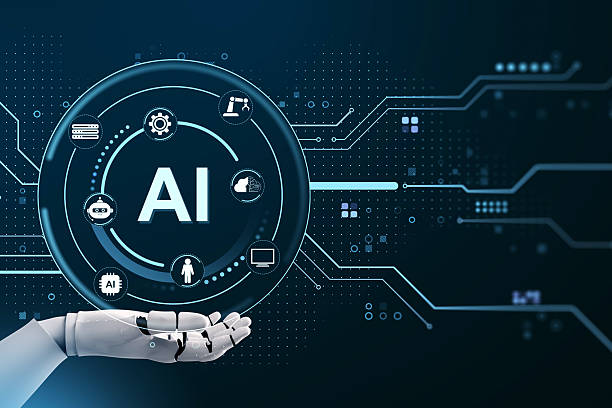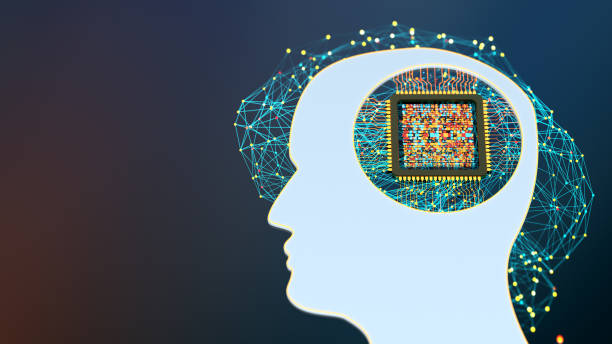What is Artificial Intelligence and How Does it Work?
Artificial Intelligence (AI) is a branch of computer science that deals with building machines capable of performing tasks that typically require human intelligence.
These tasks include learning, reasoning, problem-solving, understanding natural language, and pattern recognition.
In other words, the goal of #Artificial_Intelligence is to create systems that can think and act like humans.
The basis of Artificial Intelligence is algorithms and mathematical models that allow machines to analyze data and make decisions based on it.
These algorithms can learn from existing data and improve their performance.
For example, a facial recognition system using machine learning algorithms can learn to recognize different faces by observing different images.
One of the most important aspects of Artificial Intelligence is machine learning.
Machine learning allows machines to learn from data without explicit programming.
This process involves using various algorithms such as neural networks, support vector machines (SVM), and decision trees.
These algorithms identify patterns by analyzing data and create models that can be used for prediction and decision-making.
Artificial intelligence, using these methods, is used in various fields, including medicine, finance, and transportation.
In summary, Artificial Intelligence strives to enable machines to think, learn, and decide like humans.
This technology, using complex algorithms and mathematical models, allows machines to analyze data and act on it.
The use of Artificial Intelligence is expanding and is expected to play a more important role in our lives in the future.
Are you unhappy with the low sales of your online store?
Rasaweb is your solution for having a professional and high-selling online store.
✅ Significant increase in sales and revenue
✅ Easy and enjoyable shopping experience for customers
⚡ Get a free consultation from Rasaweb right now!
Types of Artificial Intelligence: Approaches and Classifications
Artificial intelligence can be divided into different categories based on different abilities and functions.
One of the most common classifications is dividing Artificial Intelligence into two general categories: Weak Artificial Intelligence (Narrow AI) and Strong Artificial Intelligence (General AI).
Click here to preview your posts with PRO themes ››
Weak Artificial Intelligence refers to systems designed to perform a specific task.
This type of Artificial Intelligence has been very successful in areas such as facial recognition, language translation, and computer games.
For example, facial recognition systems in smartphones or chess game algorithms like Deep Blue, which defeated the world chess champion, are examples of weak Artificial Intelligence.
These systems perform very well in the task for which they are designed, but cannot perform other tasks.
In contrast, strong Artificial Intelligence refers to systems that have intelligence similar to or beyond human intelligence.
These systems are capable of performing any task that a human can perform.
Strong Artificial Intelligence is still in the early stages of development, and so far no complete system has been created that can reach this level of intelligence.
However, extensive research is underway in this field, and many scientists believe that in the not too distant future, strong Artificial Intelligence will become a reality.
In addition to this classification, Artificial Intelligence can also be classified based on learning methods.
Supervised Learning, Unsupervised Learning, and Reinforcement Learning are among the common machine learning methods.
Each of these methods is suitable for solving specific problems and is used in various fields.
In summary, Artificial Intelligence can be divided into different categories based on abilities and learning methods.
Weak and strong Artificial Intelligence are two main categories that are determined based on the level of intelligence of the systems.
Learning methods also play an important role in the performance and applications of Artificial Intelligence.
Applications of Artificial Intelligence in Today’s World
Artificial Intelligence has very wide applications in today’s world and has transformed many industries and fields.
From medicine and healthcare to finance and marketing, Artificial Intelligence helps improve efficiency, reduce costs, and provide better services.
Click here to preview your posts with PRO themes ››
In the field of medicine, Artificial Intelligence plays an important role in diagnosing diseases, developing drugs, and providing personalized care.
Artificial Intelligence systems can diagnose diseases more accurately by analyzing medical images such as MRI and CT scans.
Also, Artificial Intelligence helps in the development of new drugs by analyzing clinical data and identifying effective compounds.
The use of Artificial Intelligence in providing personalized care also significantly improves treatment outcomes by analyzing patient data and providing treatment plans tailored to their needs.
In the financial industry, Artificial Intelligence is used in fraud detection, risk management, and providing personalized financial services.
Artificial Intelligence systems can identify suspicious patterns by analyzing financial data and prevent fraud.
Also, Artificial Intelligence helps companies make better decisions in risk management by analyzing market data and predicting changes.
The use of Artificial Intelligence in providing personalized financial services also increases customer satisfaction by analyzing customer data and providing financial suggestions tailored to their needs.
In the field of marketing, Artificial Intelligence is used in analyzing customer behavior, providing targeted advertising, and improving customer experience.
Artificial Intelligence systems can identify patterns of behavior by analyzing customer data and provide more targeted advertising.
Also, Artificial Intelligence improves customer experience by providing 24-hour support and quickly answering customer questions, increasing their satisfaction.
In addition to these, Artificial Intelligence has extensive applications in other fields such as transportation (self-driving cars), manufacturing (process optimization), and education (providing personalized education).
This technology is rapidly advancing and is expected to play a more important role in our lives in the future.
| Field | Application |
|---|---|
| Medicine | Diagnosis of diseases, drug development, personalized care |
| Finance | Fraud detection, risk management, personalized financial services |
| Marketing | Customer behavior analysis, targeted advertising, improving customer experience |
Challenges and Limitations of Artificial Intelligence
Despite significant advances in the field of Artificial Intelligence, this technology still faces challenges and limitations that prevent it from fully utilizing its capabilities.
One of the most important challenges is the lack of sufficient and high-quality training data.
Artificial Intelligence systems need a large volume of data to learn and improve their performance.
In many cases, collecting and preparing this data is difficult and costly.
Another challenge of Artificial Intelligence is the interpretability and explainability of its decisions.
In many cases, Artificial Intelligence systems make decisions that humans cannot understand the reason and how they arrived at them.
This can be problematic in areas such as medicine and law, as Artificial Intelligence decisions need to be explainable and justifiable.
Ethical issues are also among the important challenges of Artificial Intelligence.
The use of Artificial Intelligence can lead to discrimination, privacy violations, and job losses.
For example, facial recognition systems may have different accuracy in recognizing the faces of people of different races, which can lead to discrimination.
Also, the collection and use of personal data by Artificial Intelligence systems can violate people’s privacy.
Concerns about job losses due to automation are also among the ethical issues related to Artificial Intelligence.
In addition to these, Artificial Intelligence still faces limitations in understanding and processing natural language and logical reasoning.
Artificial Intelligence systems perform worse in understanding complex and ambiguous concepts of natural language and reasoning about complex issues.
This can be problematic in areas such as machine translation and answering complex questions.
In summary, Artificial Intelligence faces numerous challenges and limitations, including lack of training data, interpretability of decisions, ethical issues, and limitations in understanding and processing natural language and logical reasoning.
Addressing these challenges and overcoming these limitations is essential to fully utilize the capabilities of Artificial Intelligence.
Are you falling behind in competition with large online stores?
Rasaweb, with professional online store design, brings your business online and increases your market share!
✅ Increase brand credibility and customer trust
✅ Easy shopping experience leading to more sales
⚡ Take action now to receive a free website design consultation!
The Future of Artificial Intelligence and Emerging Trends
The future of Artificial Intelligence is very bright and full of new opportunities.
With rapid advances in hardware and software, Artificial Intelligence is expected to play a more important role in our lives in the future.
One of the important trends in Artificial Intelligence is the development of strong Artificial Intelligence.
Although strong Artificial Intelligence is still in the early stages of development, extensive research is underway in this field, and many scientists believe that in the not too distant future, strong Artificial Intelligence will become a reality.
Another important trend in Artificial Intelligence is the increasing use of deep learning.
Deep learning, using deep neural networks, allows learning complex patterns from large data.
This method has been very successful in areas such as facial recognition, voice recognition, and natural language processing, and is expected to find wider applications in the future.
The development of explainable Artificial Intelligence is also among the important trends in this field.
With the increasing use of Artificial Intelligence in sensitive areas such as medicine and law, Artificial Intelligence decisions need to be explainable and justifiable.
Research in the field of explainable Artificial Intelligence seeks to create methods for clarifying and interpreting Artificial Intelligence decisions.
Also, Artificial Intelligence is expected to play a more important role in automating processes and increasing productivity in the future.
Artificial Intelligence systems can automatically perform many repetitive and time-consuming tasks, which can lead to reduced costs and increased productivity.
However, it is necessary to pay special attention to the social and economic issues resulting from automation and develop programs to support people who lose their jobs.
In summary, the future of Artificial Intelligence is bright and full of new opportunities.
The development of strong Artificial Intelligence, the increasing use of deep learning, the development of explainable Artificial Intelligence, and the increasing automation of processes are among the important trends in this field.
However, it is necessary to pay special attention to the ethical and social issues resulting from Artificial Intelligence and use this technology responsibly and sustainably.
Machine Learning: A Key Sub-Branch of Artificial Intelligence
Machine Learning (ML) is one of the main and vital sub-branches of Artificial Intelligence that allows systems to learn from data without explicit programming.
In other words, machine learning gives machines the ability to identify patterns by analyzing data and improve their predictions and decision-making based on them.
Machine learning methods are generally divided into three categories: Supervised Learning, Unsupervised Learning, and Reinforcement Learning.
In supervised learning, the system is trained using labeled data.
This means that each sample of data has a label that indicates the correct answer.
The system learns patterns by observing this data and can be used to predict the label of new data.
For example, a spam email detection system using supervised learning can identify patterns in spam emails and categorize new emails based on these patterns by observing spam and non-spam emails.
In unsupervised learning, the system is trained using unlabeled data.
In this case, the system must automatically identify patterns and structures in the data.
For example, a customer clustering system using unsupervised learning can divide customers into different groups based on their buying patterns.
In reinforcement learning, the system learns by interacting with its environment.
The system receives feedback by taking various actions in the environment and improves its policies based on this feedback.
For example, a game-playing robot using reinforcement learning can learn better strategies for playing by playing multiple games.
Machine learning plays a very important role in the development of Artificial Intelligence and is used in various fields such as facial recognition, natural language processing, product and service recommendation, and self-driving cars.
Recent advances in the field of deep learning and deep neural networks have made it possible to learn complex patterns from large data and have led to a significant improvement in the performance of Artificial Intelligence systems.
Neural Networks: The Beating Heart of Artificial Intelligence
Neural Networks are one of the most important and widely used models in Artificial Intelligence and machine learning.
These models are inspired by the structure of the human brain and consist of a large number of nodes (neurons) that are connected to each other in a layered manner.
Each node performs a simple mathematical function, and the connection between nodes is determined by weights that are adjusted during the learning process.
Neural networks are used in various fields such as image recognition, natural language processing, voice recognition, and time series prediction.
One of the most important features of neural networks is the ability to learn complex patterns from large data.
Using appropriate learning algorithms, neural networks can identify patterns by observing data and create models that can be used for prediction and decision-making.
One of the advanced types of neural networks is Deep Neural Networks (DNNs).
Deep neural networks consist of a large number of layers and can learn very complex patterns from data.
Deep Learning refers to the process of training deep neural networks.
Deep learning has become one of the most popular and widely used methods in Artificial Intelligence in recent years due to advances in hardware and software.
Deep neural networks are used in various fields such as facial recognition, voice recognition, machine translation, and self-driving cars.
For example, facial recognition systems using deep neural networks can recognize people’s faces with very high accuracy.
Also, machine translation systems using deep neural networks can translate texts from one language to another with very high quality.
In summary, neural networks are one of the most important and widely used models in Artificial Intelligence and machine learning.
These models are inspired by the structure of the human brain and consist of a large number of nodes that are connected to each other in a layered manner.
Deep neural networks, using a large number of layers, can learn very complex patterns from data and are used in various fields.
Natural Language Processing: A Bridge Between Humans and Machines
Natural Language Processing (NLP) is a branch of Artificial Intelligence that allows machines to understand, interpret, and produce human language.
In other words, natural language processing gives machines the ability to interact with human language and perform tasks such as machine translation, answering questions, summarizing texts, and analyzing sentiments.
Natural language processing uses various techniques such as machine learning, neural networks, and statistical algorithms.
One of the most important steps in natural language processing is Parsing.
In this step, the grammatical structure of sentences is analyzed and the relationships between words are determined.
Another important step is Semantic Analysis.
In this step, the meaning of words and sentences is understood and the relationships between them are determined.
One of the important applications of natural language processing is machine translation.
Machine translation systems can translate texts from one language to another using natural language processing techniques.
Modern machine translation systems have become very advanced and can translate texts with very high quality.
Tools like Google Translate are examples of these systems.
Another important application of natural language processing is answering questions.
Question answering systems can understand users’ questions and provide appropriate answers using natural language processing techniques.
These systems are used in various fields such as customer service, education, and information retrieval.
Natural language processing plays a very important role in the development of Artificial Intelligence and allows machines to interact with human language and perform various tasks.
Recent advances in the field of deep learning and deep neural networks have led to a significant improvement in the performance of natural language processing systems.
| Application | Description |
|---|---|
| Machine Translation | Translating texts from one language to another |
| Question Answering | Providing appropriate answers to users’ questions |
| Text Summarization | Summarizing long texts into shorter texts |
| Sentiment Analysis | Detecting the emotions and opinions of people in texts |
Did you know that 85% of customers check your company’s website before any interaction?
With Rasaweb, build a corporate website that deserves your credibility.
✅ Increase brand credibility and customer trust
✅ Attract high-quality leads
⚡ Get a free website design consultation
How to Learn Artificial Intelligence?
Learning Artificial Intelligence can be an exciting and challenging process.
Given the rapid advances in this field, continuous learning and staying up-to-date with the latest techniques and methods is essential.
To start learning Artificial Intelligence, you can use various resources such as online courses, books, articles, and practical projects.
One of the best ways to start learning Artificial Intelligence is to participate in online courses.
Websites such as Coursera, edX, and Udacity offer various courses in the field of Artificial Intelligence and machine learning.
These courses are usually taught by prominent university professors and include educational videos, exercises, and practical projects.
Coursera courses are one of the best options for learning.
Books can also be a good resource for learning Artificial Intelligence.
There are many books in the field of Artificial Intelligence and machine learning that cover various topics such as machine learning algorithms, neural networks, natural language processing, and reinforcement learning.
Some of the famous books in this field include “Artificial Intelligence A Modern Approach” by Stuart Russell and Peter Norvig and “Pattern Recognition and Machine Learning” by Christopher Bishop.
Practical projects also play a very important role in learning Artificial Intelligence.
By doing practical projects, you can put the concepts and techniques you have learned into practice and gain experience.
You can do simple projects such as spam email detection, facial recognition, and stock price prediction.
Also, you can participate in open-source Artificial Intelligence projects and learn from the experiences of others.
In summary, learning Artificial Intelligence is a continuous and challenging process.
To start learning Artificial Intelligence, you can use online courses, books, and practical projects.
With practice and perseverance, you can gain skills in this field and become an Artificial Intelligence specialist.
The Impact of Artificial Intelligence on the Future of Work
Artificial Intelligence (AI) is dramatically changing the job landscape and has a profound impact on how work is done in various industries.
Automation of processes, increased productivity, and the creation of new job opportunities are among the key effects of Artificial Intelligence on the labor market.
However, these changes can also bring challenges, such as the loss of some jobs and the need to learn new skills.
One of the most important impacts of Artificial Intelligence is the automation of processes.
Artificial Intelligence systems can automatically perform many repetitive and routine tasks, which leads to reduced costs and increased productivity.
Automation can be applied in various fields such as manufacturing, customer service, and data management.
However, automation can lead to the loss of some jobs that depend on performing repetitive and routine tasks.
Artificial Intelligence can also lead to increased productivity.
Artificial Intelligence systems can help individuals make better decisions and do things more effectively by analyzing data and providing suggestions.
For example, Artificial Intelligence systems can help doctors diagnose diseases, engineers design products, and managers plan strategically.
Increased productivity can lead to increased profitability and economic growth.
In addition, Artificial Intelligence can also create new job opportunities.
The development and implementation of Artificial Intelligence systems require specialists with specific skills such as machine learning, neural networks, and natural language processing.
Also, Artificial Intelligence can lead to the creation of new jobs in fields such as data analysis, data engineering, and risk management.
People with STEM (Science, Technology, Engineering, and Mathematics) skills will have a greater chance of success in the future labor market.
However, to benefit from the opportunities created by Artificial Intelligence, individuals need to learn new skills and adapt to changes in the labor market.
Continuous learning, acquiring technical skills, and developing soft skills are among the actions that can help individuals succeed in the future labor market.
Frequently Asked Questions
| Question | Answer |
|---|---|
| 1. What is Artificial Intelligence (AI)? | It is a branch of computer science that aims to create machines capable of simulating human intelligence and performing tasks that require human thinking, such as learning, problem-solving, and decision-making. |
| 2. What are the main types of Artificial Intelligence? | They can be classified into Weak Artificial Intelligence (Narrow AI) that focuses on a specific task, General Artificial Intelligence that has comprehensive human capabilities, and Super Artificial Intelligence that exceeds human intelligence. |
| 3. Mention some common applications of Artificial Intelligence in our daily lives. | These include voice assistants (such as Siri and Alexa), recommendation systems (such as Netflix and Amazon), self-driving cars, facial recognition systems, and spam filters. |
| 4. What is the difference between Artificial Intelligence and Machine Learning? | Artificial Intelligence is the broader concept of creating intelligent machines, while Machine Learning is a subset of Artificial Intelligence that focuses on enabling systems to learn from data without explicit programming. |
| 5. What is Deep Learning? | It is a subset of Machine Learning that uses multi-layered artificial neural networks (deep neural networks) to process data and discover complex patterns, and is used in image and speech recognition. |
| 6. What are the most prominent benefits of Artificial Intelligence? | Improving efficiency and productivity, automating repetitive tasks, making better decisions based on big data analysis, and developing solutions to complex problems in areas such as medicine and science. |
| 7. What are the main challenges facing the development and deployment of Artificial Intelligence? | These include the need for vast amounts of high-quality data, privacy and security issues, bias in data and algorithms, and high development and maintenance costs. |
| 8. Does Artificial Intelligence raise ethical or social concerns? | Yes, it raises concerns about privacy, algorithmic bias, job losses due to automation, and responsibility for errors committed by intelligent systems, and the need for a regulatory framework. |
| 9. How can Artificial Intelligence affect the future of the labor market? | It can lead to the automation of some routine tasks, but it will also create new jobs that require advanced skills in developing, operating, and maintaining Artificial Intelligence systems. |
| 10. What are some modern or promising technologies in the field of Artificial Intelligence? | These include advanced Natural Language Processing (NLP) (such as large language models like ChatGPT), computer vision, robotics, and Generative AI. |
And other services of Rasa Web advertising agency in the field of advertising
Smart Brand Identity: A creative platform to improve click-through rate by intelligently analyzing data.
Smart Marketing Automation: A creative platform to improve customer acquisition with custom programming.
Smart Brand Identity: Designed for businesses looking to increase sales through attractive UI design.
Smart Digital Advertising: Professional optimization to improve SEO ranking using custom programming.
Smart UI/UX: Designed for businesses looking to increase click-through rates through marketing automation.
And more than hundreds of other services in the field of internet advertising, advertising consulting, and organizational solutions
Internet Advertising | Advertising Strategy | Reportage Ad
Sources
What is the use of artificial intelligence?
,Everything about artificial intelligence
,Introductory training in artificial intelligence
,

